This section provides recommendations for implementing global conditions between different Control-M installations.
Frequent updates to a global condition (toggles)
If the status of a global condition frequently changes (is added and deleted) within a short period of time, the Global Conditions server might become overloaded and the global conditions might not be distributed correctly.
To prevent this problem, find a balance for Global Conditions server processing by setting appropriate values using Global Conditions Server Parameters options from the root menu. These parameters define how the Global Conditions server should handle frequent updates to global conditions. For details, see the following menu options in the Control-M Administrator Guide:
Bi-directional global conditions
Global conditions can be “bi-directional,” meaning that if a global condition is added or deleted in one of several Control-M installations, it is automatically added to or deleted from the others.
However, the definition of bi-directional global conditions generates additional overhead and puts additional stress on system processing, particularly in the Global Conditions server. This can slow down other requests and data transmissions. For this reason, BMC Software recommends that you avoid implementing bi-directional global conditions.
You can achieve the benefits of bi-directional global conditions using regular,one-way global conditions. This more efficient alternative involves:
A sample implementation is provided below, first using bi-directional global conditions and then by simulating the use of bi-directional global conditions.
Sample scenario
A set of jobs can only run if the company’s intranet is up and running at all sites. Therefore, all sites (Control-M installations) have cyclic jobs that, at regular intervals, check intranet status and update the status using global conditions. If a particular intranet site in the company is down, a job deletes the global conditions that indicate that the intranet is up and running.
In this scenario, the company has two sites:
In Seattle, a job called CheckS checks and updates conditions starting with the Intranet prefix (such as IntranetS-Up and IntranetL-Up). In London, a job named CheckL performs the same function. Addition and deletion of conditions with the Intranet prefix in either location should always occur in both locations.
Using bi-directional global conditions (not recommended)
The following representation of the Global Conditions window illustrates a basic and intuitive way to define bi-directional global conditions.
Prefix |
From Control-Ms |
To Control-Ms |
|---|---|---|
Intranet |
Seattle, London |
London, Seattle |
This definition specifies that addition and deletion of a condition that begins with the characters Intranet in either the Seattle or London site automatically generates the same update at the other site. This is a valid definition for bi-directional global conditions, but is not efficient.
Using regular global conditions (recommended)
For more efficient distribution and processing of global conditions, define jobs and global condition prefixes as follows.
The setup
In this scenario, you would create the following job processing definitions:
Jobs |
Purpose |
|---|---|
CheckS |
In Seattle, this job checks intranet status and updates global conditions starting with the prefixes defined below. This job updates two global conditions (instead of one, Intranet, as was done in the sample above) with each global condition representing one direction. CheckS updates conditions with an West2East prefix. Updates to these conditions are passed towards the East to London. |
CheckL |
In London, checks intranet status and updates global conditions starting with the prefixes defined below. This job updates two global conditions (instead of one, Intranet, as was done in the sample above) with each global condition representing one direction. CheckL updates conditions with an East2West prefix. Updates to these conditions are passed towards the West to Seattle. |
MaintainS |
Dummy job processing definition in Seattle for removing global conditions that are no longer necessary; serves administrative and maintenance purposes only. MaintainS tracks, and deletes, unnecessary conditions by updating dummy global conditions. |
MaintainL |
Dummy job processing definition in London for removing global conditions that are no longer necessary; serves administrative and maintenance purposes only. MaintainL tracks, and deletes, unnecessary conditions by updating dummy global conditions. |
Define the following job global condition prefixes:
Prefix |
From Control-Ms |
To Control-Ms |
|---|---|---|
East2West |
Seattle |
London |
West2East |
London |
Seattle |
Processing flow: an overview
The following figure provides an overview of the processing flow of jobs defines when implementing the recommended practice for simulating bi-directional global conditions. Each phase in the processing flow is numbered and described in detail under Processing flow: Step by Step below.
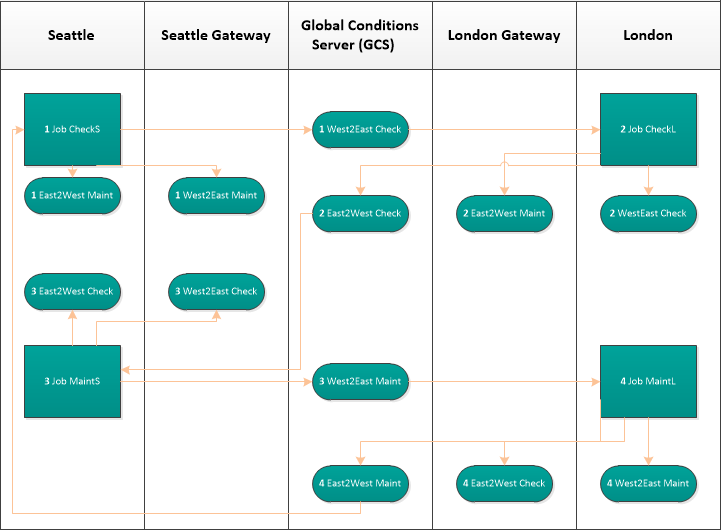
Processing flow: step-by-step
This job:
The Global Conditions server passes this condition to London.
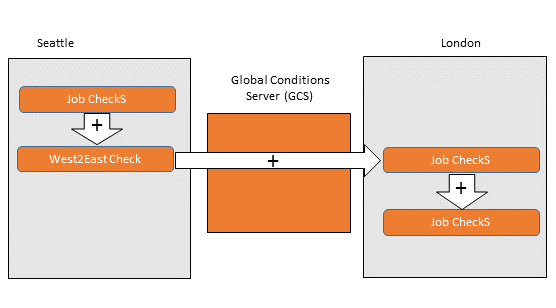
This job
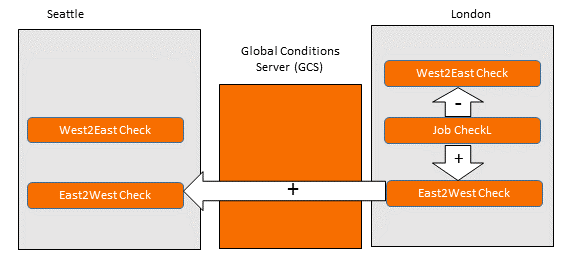
Because this condition was already deleted by CheckL in London, processing is minimal.
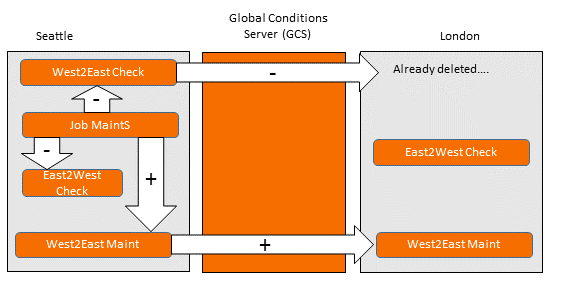
Again, because this condition was already deleted in Seattle, processing is minimal.

When the CheckS job runs, it
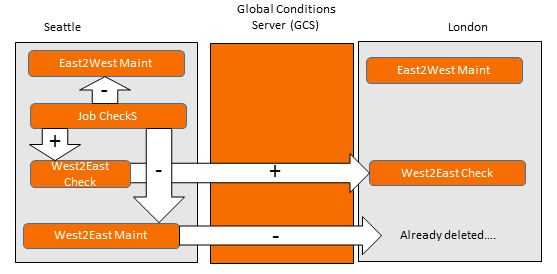
When the CheckL job runs, it:
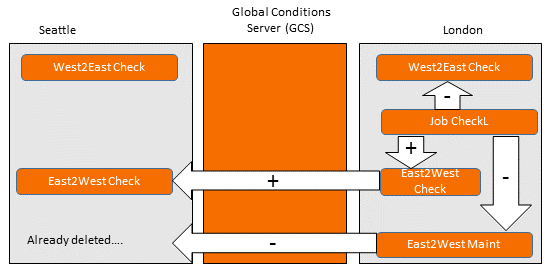
Parent Topic |